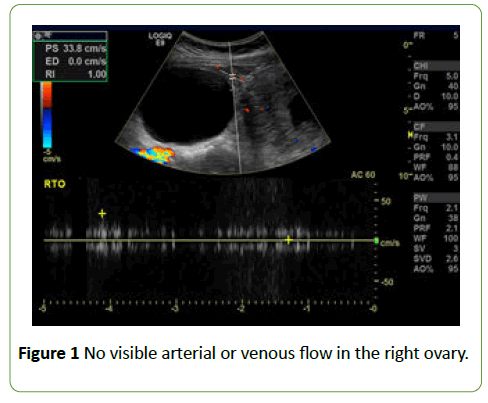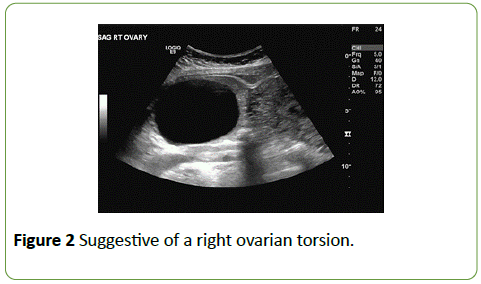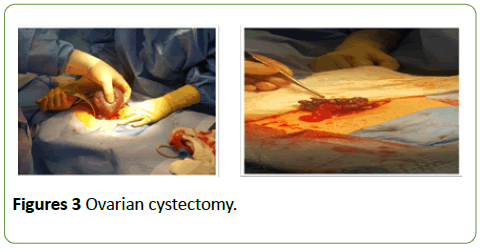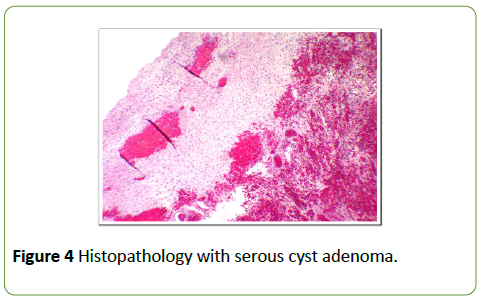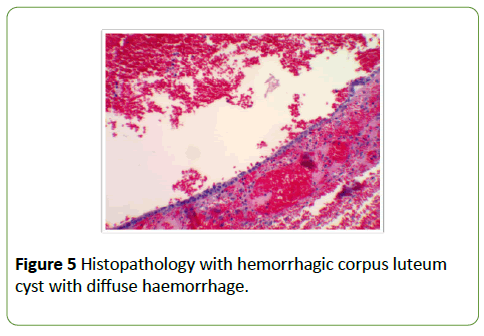Azadeh Nasiri*, Salma Rahimi and Edmund Tomlinson
South Nassau Communities Hospital - Oceanside, NY, USA
- *Corresponding Author:
- Azadeh Nasiri
South Nassau Communities Hospital
- Oceanside, NY, USA
Tel: 8777688462
E-mail:azadeh.nasiri@snch.org
Received date: May 16, 2017; Accepted date: June 14, 2017; Published date: June 19, 2017
Citation: Nasiri A, Rahimi S, Tomlinson E. Ovarian Torsion in Pregnancy: A Case Report. Gynecol Obstet Case Rep 2017, 3:2. doi:10.21767/2471-8165.1000051
Keywords
Ovarian torsion; Hemorrhage and necrosis; Torsion or infarction
Introduction
Torsion of the ovary is the total or partial rotation of the adnexa around its vascular axis or pedicle. Although the exact etiology is unknown, common predisposing factors include moderate size cyst, free mobility and long pedicle. Most common types of ovarian cysts are dermoid and serous cystadenomas. Complete torsion causes venous and lymphatic blockade leading to stasis and venous congestion, hemorrhage and necrosis. The cyst becomes tense and may rupture, leading to acute onset abdominal pain, a common presenting symptom in patients. There is a 5-fold increased risk of ovarian torsion during pregnancy, with an incidence of 5 per 10,000 pregnancies [1]. Torsion of ovarian tumors occurred predominantly in the reproductive age group. The majority of the cases presented in pregnant (22.7%) than in non-pregnant (6.1%) women [2]. We report a case of ovarian torsion in pregnancy.
Case Presentation
A 31-year-old Gravid 1 Para 0 at 10 weeks, 1 day of gestation presented to the emergency department with chief complaint of sudden onset right lower quadrant pain which woke her from sleep. She described the pain as sharp and non-radiating type with no alleviating factors and reported 3 episodes of emesis. Reported history of ovarian cyst prior to pregnancy but was not sure about the size. Otherwise her pregnancy had been uneventful.
On examination, she was afebrile with vitals within normal limits. She had severe tenderness in right lower quadrant with guarding and no rebound tenderness. Uterus was noted to be 10-12 weeks in size with right adnexal fullness and tenderness on bimanual exam. On sterile speculum exam, cervix was closed with no bleeding noted.
Pelvic ultrasound revealed a single live intrauterine gestation of approximately 10 weeks 1 day. A large right ovarian cyst measuring 7.4 × 5.8 × 7.4 cm was noted, with no visible arterial or venous flow in the right ovary, suggestive of a right ovarian torsion (Figures 1 and 2).
Figure 1:No visible arterial or venous flow in the right ovary.
Figure 2:Suggestive of a right ovarian torsion.
After obtaining informed consent, the patient underwent exploratory laparotomy using a pfnannenstiel incision was performed under regional (spinal) anesthesia. The right ovary appeared enlarged (approximately 10 cm) and cyanotic. After delivery of the ovarian cyst from the incision, detorsion was performed with 4 rotations of the pedicle. Ovarian cystectomy was then performed without complication (Figures 3a and 3b).
Figure 3:Ovarian cystectomy.
Post-operative period was uneventful and patient discharged on post-operative day 4th Patient was recommended taking oral Progesterone to the end of 12 weeks of gestation per Maternal Fetal Medicine.
Her histopathology report was consistent with serous cyst adenoma and hemorrhagic corpus luteum cyst with diffuse hemorrhage (Figures 4 and 5).
Figure 4:Histopathology with serous cyst adenoma.
Figure 5:Histopathology of ovarian parenchyma with interspersed endometrial glands and stroma along with areas of haemorrhage.
Discussion
The incidence of adnexal torsion is unknown. In a 10-year study review ovarian torsion was 2.7 percent of emergency surgeries at a women’s hospital and it was the fifth most common surgical emergency [3].
Ovarian cysts less than 6 centimetres and appearing benign on ultrasound are generally treated conservatively as they may undergo spontaneous resolution. Cyst more than 10 centimetres is usually resected due to increased risk of malignancy, rupture or torsion. Management of cysts between 5 to 10 centimetres is controversial.
If the cysts contain septate, nodules, papillary excrescences or solid components then resection is recommended. Those with simple cystic appearance may be managed expectantly with serial ultrasound surveillance. However, they may require emergency exploratory laparotomy for rupture, torsion or infarction in as many as 50% cases [4]. Ovarian cysts during pregnancy may be managed conservatively with observation if diagnosed in the first trimester. The optimal time for surgical intervention during pregnancy is between 16 and 28 weeks of gestation. Immediate surgical intervention, irrespective of gestational age, may be warranted in cases of ovarian torsion, ruptured ovarian cyst or if there is suspicion for malignancy [4]. Diagnosis of ovarian torsion in pregnancy can be made with clinical presentations in conjunction with ultrasound with color Doppler. Treatment options limited to surgery, either by laparoscopy approach or laparotomy. Pregnancy loss seems to be very rare and postoperative progesterone supplementation is recommended when the corpus luteum is removed prior to 7 to 9 weeks of gestation [5-7].
Conclusion
Ovarian torsion is an urgent gynecological surgery and can occur during pregnancy. Surgical techniques should be considered in the development of the adnexal torsion regardless of the gestational age.
References
- Ventolini G, Hunter L, Drollinger D, Hurd WW (2007) Ovarian torsion during pregnancy.
- Lee CH, Raman S, Sivanesaratnam V (1989) Torsion of ovarian tumors: a clinicopathological study. Int JGynaecolObstet 28:21-25.
- Bouguizane S, Bibi H, Farhat Y,Dhifallah S, Darraji F, et al. (2003) Adnexal torsion: A report of 135 cases. J GynecolObstetBiolReprod (Paris) 32:535-540.
- Yen CF, Lin SL, Murk W, Wang CJ, Lee CL, et al. (2009) Risk analysis of torsion and malignancy for adnexal mases during pregnancy. FertilSteril 91:1895-1902.
- Pritts EA, Atwood AK (2002) Luteal phase support in infertility treatment: A meta-analysis of the randomized trials. Hum Reprod 17:2287-2299.
- Bourgain C, Devroey P, Van Waesberghe L,Smitz J, Van Steirteghem AC (19900) Effects of natural progesterone on the morphology of the endometrium in patients with primary ovarian failure. Hum Reprod 5:537-543.
- Cicinelli E, De Ziegler D, Bulletti C,Matteo MG, Schonauer LM, et al. (2000) Direct transport of progesterone from vagina to uterus. ObstetGynecol 95:403-406.

